Key takeaways:
- Adaptability is crucial for business survival; embracing change can lead to new revenue streams and innovative strategies.
- Independent labels face challenges such as competition, cash flow issues, and an ever-changing digital landscape, requiring creativity and resilience.
- Fostering strong industry relationships and utilizing data analytics can help navigate market shifts effectively.
- Community support and transparency during disruptions foster trust and collaboration, proving essential for resilience.
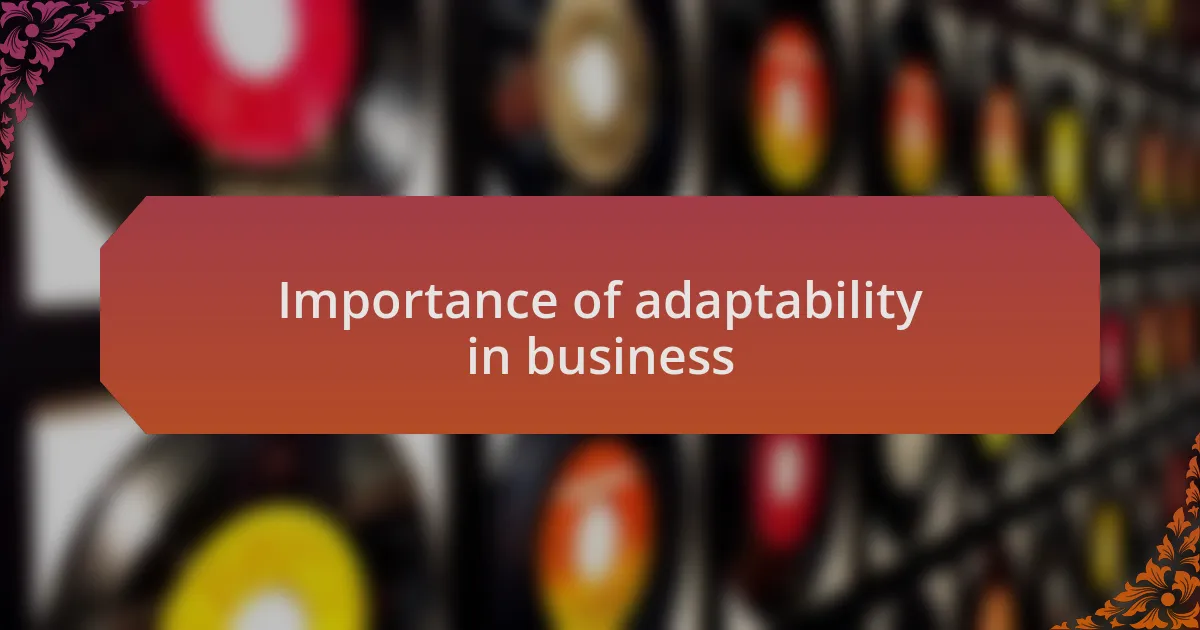
Importance of adaptability in business
Adaptability in business is not just a strategy; it’s a survival mechanism. I remember when my independent label faced rapid changes in music consumption trends. While some were stuck in traditional methods, I decided to pivot towards digital platforms, embracing streaming and social media to connect with our audience. This choice not only helped us stay relevant but also opened up new revenue streams.
Every disruption brings uncertainty and, naturally, fear. I felt it when I noticed major artists shifting to home recording during the pandemic. Instead of panicking, I viewed it as an opportunity to support local talent who were equally trying to navigate these waters. By focusing on cultivating our artist relationships and scaling our digital presence, we thrived in a landscape others deemed chaotic. Isn’t it fascinating how a shift in perspective can turn a challenge into an advantage?
Being adaptable also means fostering a culture that welcomes change. I often stress to my team the importance of continuous learning and being open to new ideas. This approach has paid off, as we’ve generated innovative marketing strategies that resonate with changing consumer tastes. What if every business prioritized flexibility? I believe we’d see a wave of creativity that could revolutionize entire industries.
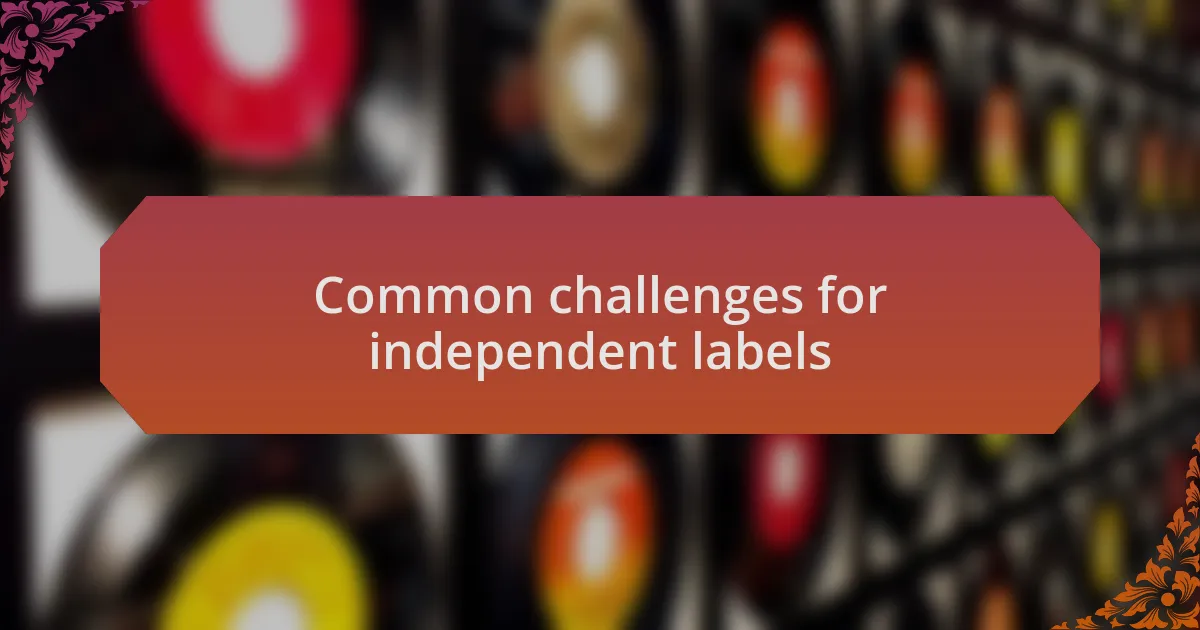
Common challenges for independent labels
Independent labels often face a myriad of challenges, particularly in a constantly evolving music landscape. One prevalent issue is the ever-changing digital landscape. I still recall spending countless hours trying to decipher the latest algorithms on streaming platforms, understanding how they might affect our visibility. It’s daunting when you realize that an entire strategy can hinge on something as unpredictable as an algorithm change.
Another common hurdle is the fierce competition from bigger labels and their resources. I remember the moment I learned that a major artist was suddenly signed by a competitive label we were in talks with. It felt like a setback, yet it ignited a fire in me to innovate. This experience taught me that while we may lack the budget for flashy marketing campaigns, I could leverage our unique artist relationships and grassroots efforts to carve out a distinct niche in the market.
Cash flow can become a significant worry for independent labels, especially during tough economic times. I’ve experienced that nervous feeling when invoices begin piling up, and I must wait for streaming royalties to trickle in. It’s a challenge that many face, but I’ve found that diversifying income sources—like hosting live virtual events or selling exclusive merchandise—can provide a buffer during financially lean periods. Isn’t it interesting how necessity breeds creativity in business?
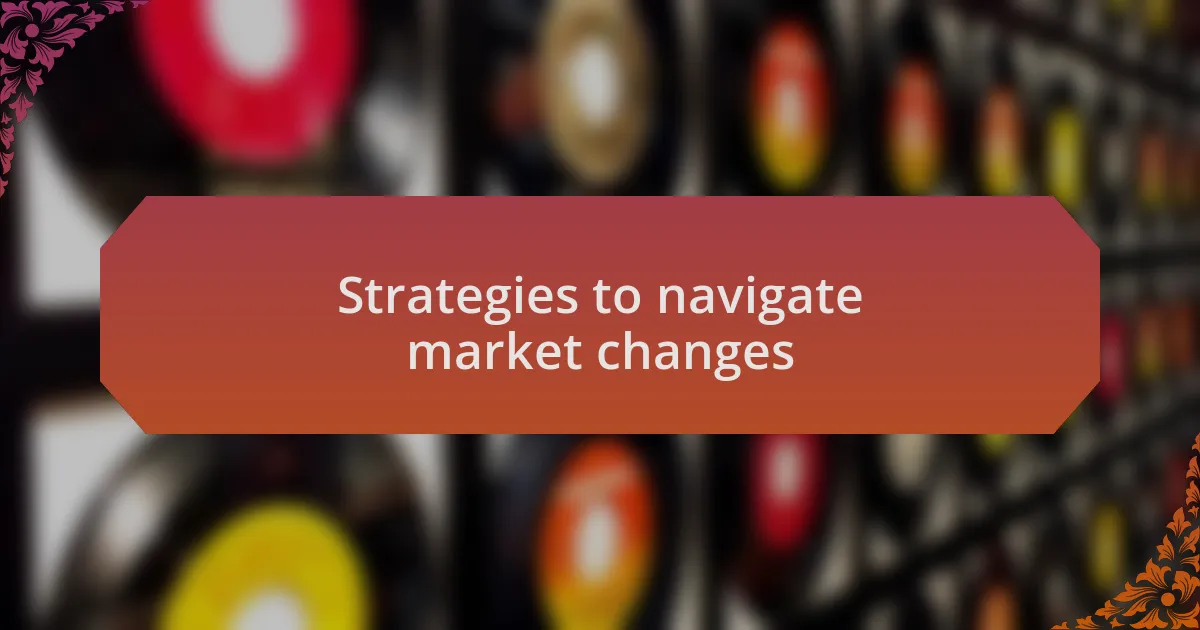
Strategies to navigate market changes
To effectively navigate market changes, one strategy that has served me well is staying agile. A memorable moment was when a surge in popularity for a particular genre gave us an unexpected opportunity. We quickly shifted our focus and started promoting artists in that genre through targeted social media campaigns. It felt exhilarating to adapt our strategy almost on-the-fly, and the resulting increase in engagement was a testament to how being responsive can really pay off.
Another tactic involves fostering strong relationships within the industry. I vividly recall attending a music conference where I met other label owners and industry professionals. Those connections proved invaluable when it came to sharing resources and insights during challenging times. Have you ever found that conversations with peers can inspire innovative solutions? I have, and it’s often those discussions that lead to collaborations or shared marketing efforts that empower us to tackle shifts in the market together.
Moreover, leveraging data analytics can illuminate patterns that inform strategic decisions. I still remember the night I spent poring over streaming data and realized one of our lesser-known artists was experiencing a spike in plays. This insight prompted us to elevate their profile with a focused marketing push. Isn’t it fascinating how numbers can reveal opportunities? Utilizing data not only helps in making informed decisions but also allows us to anticipate market shifts, keeping us one step ahead in this unpredictable environment.
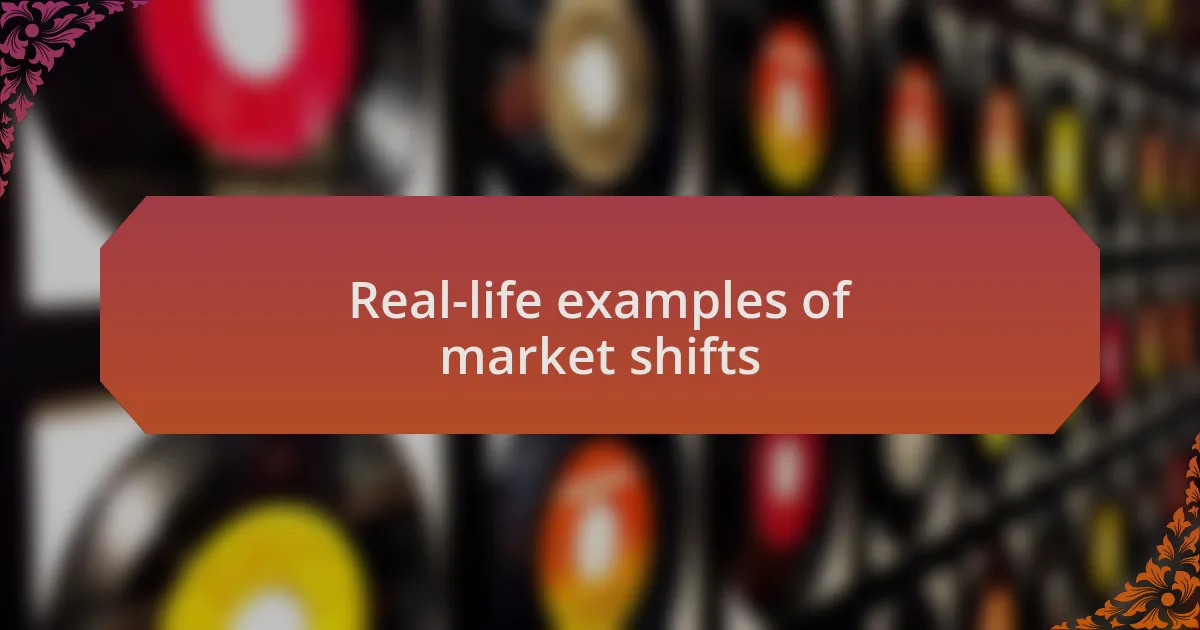
Real-life examples of market shifts
One striking example of a market shift occurred when the global pandemic hit in 2020. I was shocked by how quickly everything changed—concerts were canceled overnight, and artists were scrambling to stay relevant. In this uncertain environment, I pivoted towards virtual events, organizing live-streamed performances that allowed our artists to connect with fans from the safety of their homes. Did you ever think a live-stream could attract a larger audience than a physical concert? It certainly surprised me, as we witnessed an uptick in engagement and even sales through digital merchandise.
Looking back, the rise of platforms like TikTok transformed how we approached marketing for emerging artists. I remember working with a new artist who created a catchy snippet for a song that quickly went viral on the app. The momentum from that brief clip spurred an unexpected interest in their full album, reminding me that sometimes the most innovative forms of promotion emerge organically from shifts in social media trends. Have you ever felt like the smallest spark can ignite a much bigger flame? I have truly seen that potential firsthand.
Also, the shift towards independent artist empowerment altered the market considerably. I’ll never forget the moment a well-known artist decided to leave their mainstream label to go independent, inspiring many others to follow suit. It was a race against time for us to show our roster that we could offer them a supportive and nurturing environment, filled with creative freedom. The result was exhilarating; as artists flocked to us, we not only expanded our roster but also reinforced our commitment to helping artists carve their own paths in a way that didn’t compromise their vision. Isn’t it remarkable how a bold move can reshape the entire landscape?
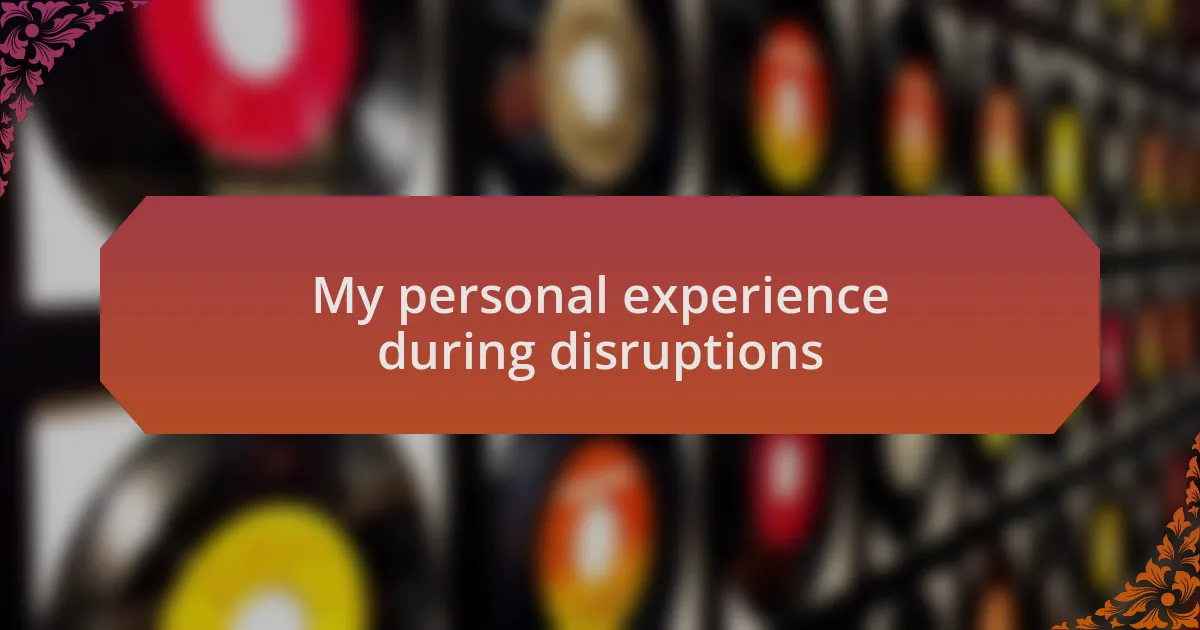
My personal experience during disruptions
During the early days of the pandemic, I felt a rush of anxiety as I watched our plans unravel. I distinctly remember a meeting with my team, where we all shared our fears; it felt like standing on the edge of a cliff. That anxiety pushed us to embrace creativity in ways I hadn’t imagined, leading to brainstorming sessions that sparked ideas for online platforms, merch drops, and collaborations that we had never considered before.
As events shifted dramatically, I often found myself reminiscing about the intimate gatherings we used to host. It was during one of these live-stream events that I witnessed a beautiful moment; an artist broke down in tears while performing, connecting with fans who shared their own struggles in the chat. I realized then how vital these virtual spaces had become—they not only kept the music alive but also created a community when people needed it most. Have you ever felt like music was the lifeline that brought people together in challenging times? For me, it was like a warm hug in a cold world.
There was a period when I felt a shift in energy among the artists I supported. A few expressed their desire to take control of their narrative, and it struck a chord with me. I vividly recall sitting in a dimly lit studio, listening to one passionate artist lay out their vision of independence. This moment cemented my belief that disruptions, while daunting, could breed empowerment and authenticity. Isn’t it fascinating how a crisis can unveil the most profound truths about our passions?
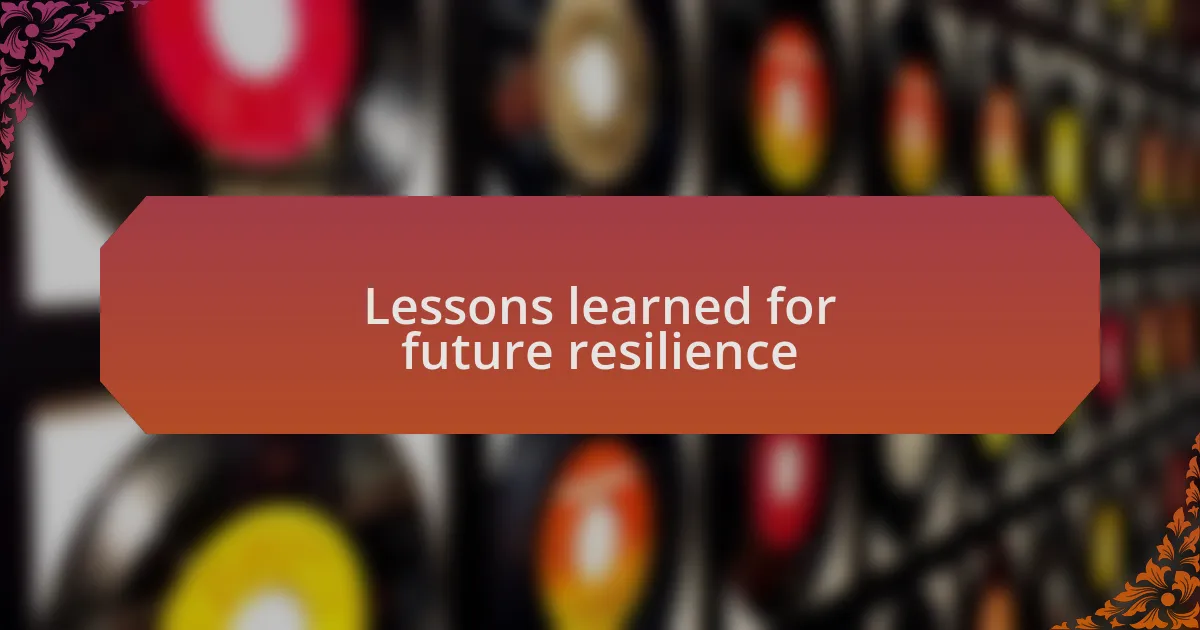
Lessons learned for future resilience
Adaptability became my guiding principle amid the chaos. I recall a late-night conversation with a mentor who reminded me that flexibility isn’t just a response to change; it’s a proactive strategy. That advice resonated deeply, as when I began to experiment with different formats for our music releases, I noticed how openness to change not only preserved our brand but also opened doors to new audiences. Have you ever considered how being adaptable could ultimately define your path in difficult times?
One of the most poignant lessons I’ve learned is the power of community support. I still reflect on a small fundraiser we organized to assist struggling artists. Everyone rallied together, and I remember the smiles on their faces when they received unexpected funds. It was a reminder that during disruptions, collaboration can create a powerful network of encouragement. Have you thought about how community can be a significant pillar during tough times?
Looking back, it’s clear that transparency fostered trust. I made it a point to communicate openly with both artists and fans. When I shared our struggles and sought feedback, I was surprised by the level of engagement and support that followed. People appreciate honesty, especially during uncertainty. So, what if we all made a conscious effort to prioritize transparency as a resilience-building tool? The benefits can be far-reaching.